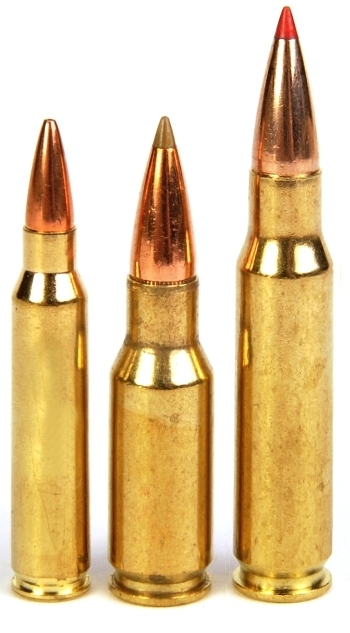
A lot of what we do in the shop, stays in the shop and never makes it to publication. It’s not as though we are running a covert operation. it’s just that much of the subject matter lacks broad appeal; the flipper autoloader, the pivoting cylinder revolver and the propellant distilled from banana skins to name a few. Still, we like designing our own guns and cartridges. It keep our firearm interests high, the effort is always educational and it gives us a chance to get exposure to some really talented people.
Some time ago, while working with the Remington R15, I began to gain an appreciation for the 30 Remington AR cartridge (L-R: .223 Remington. 30 Remington AR, .308 Winchester). The 30 Remington AR is an excellent cartridge, even with its wings clipped for an AR-15 application; relatively low chamber pressure for proper gas port/pressure timing, a significant case taper to assure reliable feed, a rather long neck to accommodate a 0.308″ bullet, and the use of light for caliber bullets consistent with a somewhat modest case capacity.
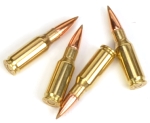
The 30 Remington AR could possibly accomplish something a .308 Winchester length cartridge could not; be the basis for an inexpensive five pound medium size game rifle. .308 Winchester length cartridges tend to show up in full size guns, or with weight saving barrel lengths that significantly diminishes ballistic performance. In the case of the .30 Remington AR, neither rule applies. It seemed that the 30 Remington AR’s performance could be optimized with a minimal investment in tooling and without a lot of rework of an existing firearm.
It’s like the Sports Illustrated swimsuit issue… No, it is not like that at all
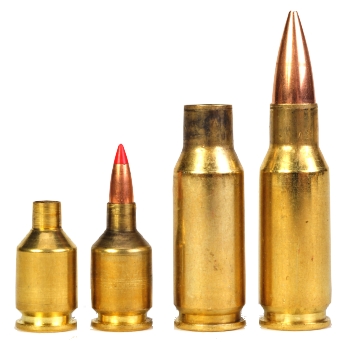 So we began cartridge modeling – running up and down the case capacity, bore volume, barrel length, and pressure scale, looking for a combination that might yield something good. This is not our first stubby wildcat cartridge rodeo.
So we began cartridge modeling – running up and down the case capacity, bore volume, barrel length, and pressure scale, looking for a combination that might yield something good. This is not our first stubby wildcat cartridge rodeo.The .17-357RG established a baseline we thought would apply; short length for a very compact action, a relatively large case diameter for reasonable powder capacity, with “reasonable” capacity resulting in near complete burn in a short barrel. Where the .17-357RG’s dramatic proportions lend themselves to varmint guns, the new cartridge would need to be adjusted significantly upward to make its top loads solidly suitable for hunting deer, hogs, antelope, etc..

The cartridges, right, suggest we were not completely… goofy, in our first assessment that the 30 Remington AR was a case with further potential. The .220 Swift, at 47 grains, has only 3 grains more capacity than the 30 Remington AR, the .22-250 Remington holds one half grain less which meant, if would neck the case down to take a o.224″ bullet and run up the pressure a bit, we could probably duplicate the Swift and .22-250’s 4,000 fps performance. Not bad for a stubby little cartridge, but that is moving in the opposite direction in terms of our objectives.
The 30 Remington AR has the same capacity as the .30-30 WCF, however, the 30 Remington AR in AR-15 type equipment operates at pressure levels 13,000 PSI greater than the .30-30 WCF with probably another 10,000 PSI potential in a stronger bolt action firearm. So with both the glow and the slow ends of the velocity performance spectrum pegged for reference, we began to look at what might fall in between.
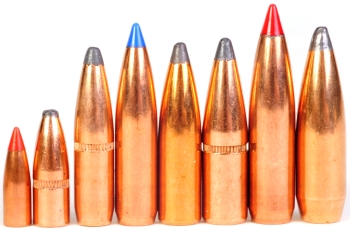
The tendency is often to crank down the bullet diameter to pump up the velocity. Unfortunately, sometimes that approach gives away too much bullet weight and results in a marginal deer cartridge. Because of case powder capacity constraints, I felt anything 0.257″ and smaller would not fly fast enough to provide optimal momentum for good penetration, bullet expansion and kinetic energy. Both the 0,264″ and 0.277″ bullets looked good, but the heavy weights in those calibers were long and would encroach on case capacity. The 0.284″ seemed to hold the greatest promise.
The QuickLOAD and RCBS.Load influences…
QuickLOAD figured heavily in early analysis. It allowed construction of several variations of custom cartridges, a look at the mechanical influence of specific bullet weights calibers combinations and an examination of predicted interior and exterior ballistics. QuickLOAD draws from a static database of actual component values. The results are not perfect, but after comparing them to our own strain and piezo transducer equipment results over the long term, the conclusion is that QuickLOAD is a good reflection of real world results and its use can save a lot of development time and money.
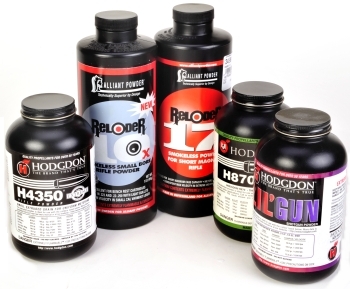 As in no way illustrated by the gratuitous and irrelevant photograph of powder, left, a cartridge case full of smokeless powder will typically out perform a partially filled case. Unfortunately, some case/component combinations make full case loading impossible, which leaves the handloader with either a 90% full case and 100% pressure goal or a 100% full case with pressures 10%-15% below optimal. The industry responds to the situation by routinely introducing powder types to keep pace with evolving cartridge designs. Part of our analysis was trying component / capacity combinations in search of those that would make full case loading achievable.
As in no way illustrated by the gratuitous and irrelevant photograph of powder, left, a cartridge case full of smokeless powder will typically out perform a partially filled case. Unfortunately, some case/component combinations make full case loading impossible, which leaves the handloader with either a 90% full case and 100% pressure goal or a 100% full case with pressures 10%-15% below optimal. The industry responds to the situation by routinely introducing powder types to keep pace with evolving cartridge designs. Part of our analysis was trying component / capacity combinations in search of those that would make full case loading achievable.Two other factors analyzed prior to committing to a case design were percentage of powder burn and the effects of barrel length on velocity based on caliber and bullet weight. Usually, diminishing bore size, with a constant case powder capacity will result in a need for ever longer barrels which contradicted our goal of a very lightweight rifle. In the case of the 0.284″ bullet and approximately forty five grains of powder capacity, the magic number was about a twenty one inch barrel. Going shorter resulted in a significant drop in velocity, going longer offered little in a velocity gain. A twenty one inch barrel with a standard sporter contour would not pull along much more weight than a twenty inch barrel, nor would it add significant length to the rifle.

Once the dynamics of a new cartridge were sorted out and the design of greatest potential was selected, RCBS.Load was used to do the case drawings for the production of reamers and other tooling. RCBS.Load is probably one of the most underrated software products on the market. Beyond the reloading data component , the CAD function is excellent and RCBS.Load contains so many tools for analysis and comparison within a group of cartridges.
The 7mm-30 RG (Real Guns)
When the design machine stopped… silencing its clunking, banging, whirling and kerchunking, it spit out the 7mm-30RG (RealGuns.Com). Drawings and prototype cases were completed on 4/24/2010. The design was frozen and a commitment was made to cartridge, firearm and handload tooling on 6/22/2010. It is not meant to be a breakthrough wildcat, nor do I think it represents anything more than a modest modification to an existing round. The value of the cartridge is in serving as a way to convey all of the steps, including warts, mistakes and sidetracking that stand between a product of our imagination and a gun that goes bang.
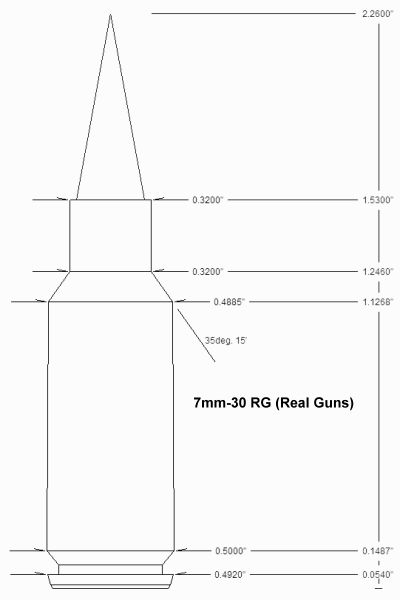
The 30 Remington AR is most often noted as a .284 Winchester derivative, however, the 30 Remington AR has a larger rebated rim; 0.492″ compared to 0.473″ for the .284 Winchester rim.
The 7mm-30RG is formed from the 30 Remington AR as this minimizes rework required to fabricate 7mm-30RG brass. The slight increase in rim diameter over the .284 Remington is of no practical significance.
Case length and overall cartridge length are unchanged from the 30 Remington AR. The 7mm-30RG’s neck outside diameter was reduced to 0.3200″ from the 30 Remington AR’s 0.3420″ and shortened to 0.284″ to reflect the caliber change from 0.308″ to 0.284″.
The 7mm-30RG’s minor shoulder diameter was advanced approximately 0.0208″ in comparison to the 30 Remington AR, the major diameter was advanced approximately 0.0587″. As a result, 7mm-30RG’s shoulder angle was changed from the 30 Remington AR’s 25° to 35.
A body taper of 0.0115″ is consistent between the two cartridges, however, the 7mm-30RG taper occurs over a longer case length making the effective taper less than the 30 Remington AR. Due to the nature of the case changes, 7mm-30RG case forming is a two step process, the first cold forming, the second fire forming. As a side note – the 7mm-30RG rework adds approximately 1.5 grain greater case capacity for a total of 45.5 grains, however, the reduced incursion of the 7mm bullet in some combinations results in a gain of as much as 5 grains of net case capacity over the 30 Remington AR.
Under pressure…
The 30 Remington AR maximum pressure is 55,000 PSI, which is low by bolt gun standards as the cartridge is intended for use with a gas operated AR-15 type system, This accommodation is not necessary in a bolt action rifle, so the maximum pressure for the 7mm-30RG has been increased to 65,000 PSI, something consistent with most modern center fire rifle cartridge designs. The increase in pressure alone accounts for an approximate 5%-7% increase in velocity in a 21″ barrel gun.
Ballistic performance goals
|
||||||||||||||||||||||||||||||||||||||||||||||||||||||||||||||||||||
The velocity predictions are based on a 21″ barrel and near maximum pressure. Extending barrel length much beyond this point shows little gain in simulation as powder burn is relatively complete and muzzle pressure has dropped below 10,000 PSI. The good news is that predicted velocity historically has been found to be lower than chronograph velocity and predicted pressure is typically overstated in comparison to actual.
Placing the preceding information in perspective, the velocity of the 139 grain load for the 21″ barrel 7mm-30RG is only 100 fps less than a 24″ barrel 7mm-08 Remington, and 100 fps greater than a 24″ barrel 7×57 Mauser. At 55 grains, the 7mm-08 Remington has 22% greater powder capacity than the 7mm-30RG. At 59 grains the 7×57 Mauser has 32% greater capacity than the 7mm-30RG. None of this is ballistic headline news, however, the size and performance of the cartridge lends itself to the construction of some really interesting and lightweight hunting firearms… a combination which is exciting.
Where from here?
Unlike our current federal government, we like to work with transparency. So as progress is made we will detail and update each component of the project, cartridge and firearm, including any dead ends and obstacles we encounter, information that may save others time and aggravation.
Pacific Tool & Gauge produced the various cutting tools and gauges required for the project. Dennis Olson of Plains Montana is doing all of the clever gunsmithing that is above our pay grade and the capacity of our shop lathe. We’ll be back shortly with a progress report. Fun.

Email Notification